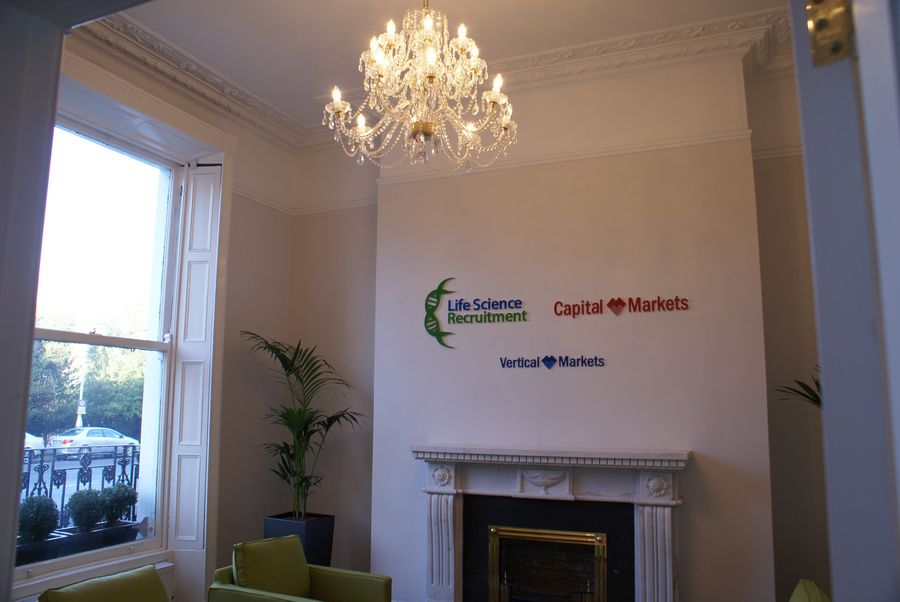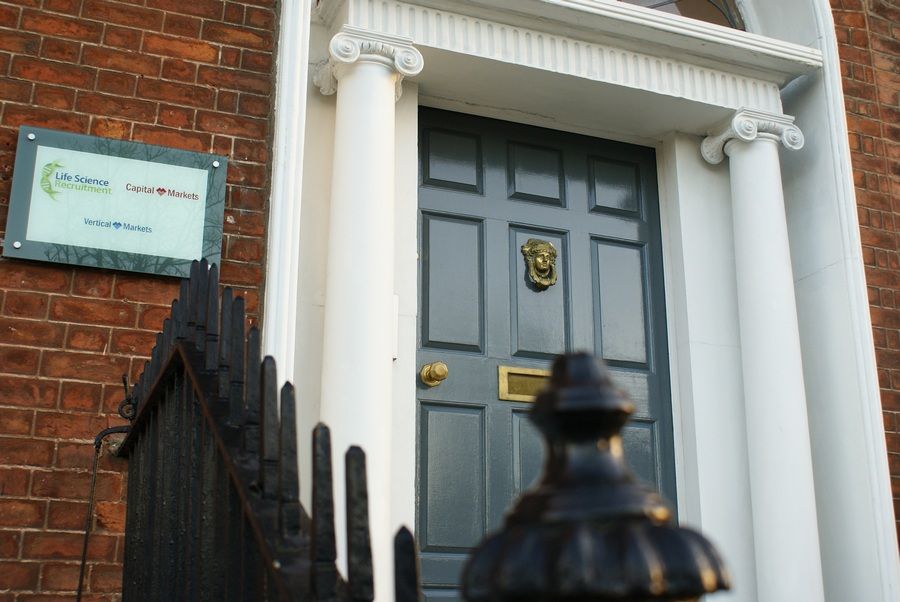Life Science Recruitment is proud to announce that we have moved to a New Dublin Location at 12 Fitzwilliam Square. Due to continued growth and expansion of the company there was a need to move to a larger premises in order to best accommodate our role as the Leading Recruitment agency for various science industries: Connected Health, Quality Control, Pharmaceutical & Healthcare, Medical, Clinical Research and all other Science Jobs etc.- the list goes on.

As our numerous clients know Life Science Recruitment has always strived to be progressive and forward thinking in our approach to Recruitment and job placement. We have always looked and worked towards the future but have a truly great appreciation of the past and what has gone before. We are very pleased with this historic building now in our care, because we believe that a connection with the past is very important when carving out the future – for us that means putting more people in the right jobs.
12 Fitzwilliam Square is a magnificent Georgian house with a long history. This beautiful building has strong ties to the Graves family among whom was Robert Graves (1895-1985), poet, novelist, biographer, mythographer & classical scholar whose grandfather Charles Graves was born here in the early 1800s.
Even more closely associated with the premises, Charles Graves (1812-1899) had great notability in his own right as Scholar and as the Anglican Bishop of Limerick, Ardfert and Aghadoe. He was also a successful mathematician.
Educated at Trinity College, Dublin from 1829 to 1835, Charles won a scholarship in the Classics. On graduating he took the gold medal in mathematics and physics – a historical fact which appealed to the team here at Life Science!
In 1841 Graves published an original mathematical work and he embodied further discoveries in his lectures and in papers read before and published by the Royal Irish Academy. He was a colleague of Sir William Rowan Hamilton and on the latter’s death Graves gave a presidential panegyric containing a valuable account both of Hamilton’s scientific labours and of his literary attainments.

Charles Graves was very interested in Irish antiquarian subjects. He discovered the key to the ancient Irish Ogham script which appeared as inscriptions on Cromlechs and other stone monuments. He also prompted the government to publish the old Irish Brehon Laws, Early Irish Law. His suggestion was adopted and he was appointed a member of the Commission to do this.
Fitzwilliam Square itself is located on the south side of the city in an area once part of the land of Baggotsrath and acquired by the Fitzwilliam family in 1381. The development of the Fitzwilliam estate was stirred by James Fitzgerald (Earl of Kildare), when he built Kildare House on Fitzwilliam’s land in 1745. The lawns of Kildare House, later renamed Leinster House, faced east and led to plans to develop Merrion street and square in the 1750’s and 1760’s. Jonathan Barker’s 1764 map of the planned Merrion square shows a street marked ‘The Intended New Street’, which corresponds with today’s Fitzwilliam street and the east side of Fitzwilliam Square and is the first indication of plans to develop in this direction. Many houses in the map are shown to take the older architectural form of the ‘Dutch Billy’, obviously before the decision to build the houses in the uniform fashion and scale that is now known as the Georgian style.
In general the leases of Fitzwilliam Square were acquired by speculators who erected houses in ones and twos and sold them off quickly. The plots of numbers 9 to 12 Fitzwilliam Square were leased by Viscount Fitzwilliam to the merchant Nathaniel Calwell at the start of the 19th Century. Calwell employed the builder and master carpenter Richard Knight to erect houses on these plots.
Members of the earlier mentioned Graves family occupied the house continually from 1814 onwards and for most of the 19th Century.
 The initiative was established on a site previously owned by Enterprise Ireland to DCU for the specific purpose of this project and will be the location of choice for Cleantech start-ups, SMEs and larger companies. Cleantech – a fast-growing area of international commerce is worth 5 trillion annually and provides insight to Fortune 1000 corporations regarding environmental challenges – wind, water and waste management to name just a few. This insight helps to make better decisions that foster growth, reduce cost and meet consumer and government demands for improved environmental quality.
The initiative was established on a site previously owned by Enterprise Ireland to DCU for the specific purpose of this project and will be the location of choice for Cleantech start-ups, SMEs and larger companies. Cleantech – a fast-growing area of international commerce is worth 5 trillion annually and provides insight to Fortune 1000 corporations regarding environmental challenges – wind, water and waste management to name just a few. This insight helps to make better decisions that foster growth, reduce cost and meet consumer and government demands for improved environmental quality.
 So what implications do social graphs have on the recruiting world?
So what implications do social graphs have on the recruiting world?
